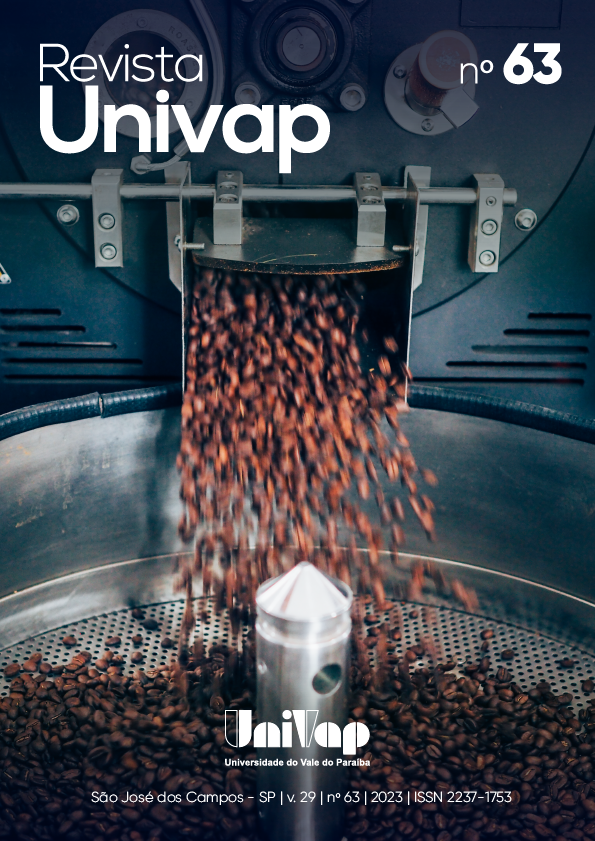PHYSICAL ACTIVITY PRACTICE OF ADOLESCENTS DURING THE COVID-19 PANDEMIC AND ASSOCIATED FACTORS
DOI:
https://doi.org/10.18066/revistaunivap.v29i63.4422Keywords:
Physical Activity, Pandemic, Associated factors, Adolescent healthAbstract
Physical activity plays an important role in adolescence, being considered an indicator of the current and future health status of young-adults. COVID-19 restrictions seem to have reverberated on the practice of physical activity (FAP) of adolescents. In this context, this study aimed to analyze the FAP of adolescents and associated factors during the COVID-19 pandemic. This is a cross-sectional study carried out with 287 adolescents. The level of physical activity was measured using a questionnaire and considered physically active if >300 minutes/week. They were evaluated questions related to self-perception of health, sociodemographic profile, and behavioral factors. Prevalence ratios (PR) and intervals with 95% confidence (95%CI) were estimated using multiple Poisson regression models with robust variance. It was verified that during the pandemic 34.8% of adolescents were insufficiently active. In the adjusted analysis remained associated the following variables: sex (PR=1.12; 95%CI1.05-1.20; p=0.001), health perception (PR=1.08; 95%CI1.01-1. 14; p=0.014), change in FAP (PR=1.13; 95%CI1.06-1.20; p=0.000) and time watching TV (PR=1.09; 95%CI1.02-1.16; p=0.006). It was observed a high prevalence of insufficiently active adolescents. Female adolescents, with a negative perception of health, which reduced their FAP during the pandemic and with excessive time in front of TV, were more likely to be insufficiently active
Downloads
References
Abreu, J. M., Souza, R. A. de., Viana-Meireles, L. G., Landeira-Fernandez, J., & Filgueiras, A. (2022). Effects of physical activity and exercise on well-being in the context of the COVID-19 pandemic. PLoS One, 17(1), e0260465. DOI: 10.1371/journal.pone.0260465
Araújo, L. G. M., Turi, B. C., Locci, B., Mesquita, C. A. A., Fonsati, N. B., & Monteiro, H.L. (2018). Patterns of Physical Activity and Screen Time Among Brazilian Children. J Phys Act Health,15(6), 457-461. DOI:10.1123/jpah.2016-0676
Araujo, R. H. O., Werneck, A. O., Barboza, L. L., Ramírez-Vélez, R., Martins, C. M. L., Tassitano, R. M., Silva, E. C. M., de Jesus, G. M., Matias, T. S., de Lima, L. R. A., Brazo-Sayavera, J., & Silva, D. R. (2022). Prevalence and sociodemographic correlates of physical activity and sitting time among South American adolescents: a harmonized analysis of nationally representative cross-sectional surveys. Int J Behav Nutr Phys Act, 19(1), 52. DOI:10.1186/s12966-022-01291-3
Bayles, M. P., Riebe, D., Herman, J. K., Liguori, G., Magal, M., & American College of Sports Medicine (Eds.). (2018). ACSM’s guidelines for exercise testing and prescription (Tenth edition). Wolters Kluwer.
Conti, M. A., & Latorre, M. R. O. (2009). Estudo de validação e reprodutibilidade de uma escala de silhueta para adolescentes. Psicologia em Estudo, 14(4), 699-706. DOI: 10.15446/rsap.v19n1.47697
Correa, R. S., Marques, A., Neufeld, A. B., Almeida, A. M., & Matos, M. G. (2022). Desenvoltura social, regulação parental e atividade física em adolescentes: um estudo de corte. Research, Society and Development, 11(8), e30111830818. DOI: 10.33448/rsd-v11i8.30818
Costa, M. P. D. S., Schmidt, A., Vitorino, P. V. D. O., & Corrêa, K. D. S. (2021). Inatividade física e sintomas de depressão, ansiedade e estresse em adolescentes estudantes. Acta Paulista de Enfermagem, 34, eAPE03364. DOI: 10.37689/acta-ape/2021AO03364
Farello, G., D'Andrea, M., Quarta, A., Grossi, A., Pompili, D., Altobelli, E., Stagi, S., & Balsano, C. (2022). Children and Adolescents Dietary Habits and Lifestyle Changes during COVID-19 Lockdown in Italy. Nutrients,14(10), 2135. DOI: 10.3390/nu14102135
Greier, K., Drenowatz, C., Ruedl, G., & Riechelmann, H. (2019). Association between daily TV time and physical fitness in 6- to 14-year-old Austrian youth. Transl Pediatr, 8(5), 371-377. DOI: 10.21037/tp.2019.03.03
Guan, W. J., Ni, Z. Y., Hu, Y., Liang, W. H., Ou, C. Q., He, J. X., Liu, L., Shan, H., Lei, C. L., Hui, D. S. C., Du, B., Li, L. J., Zeng, G., Yuen, K. Y., Chen, R. C., Tang, C. L., Wang, T., Chen, P. Y., Xiang, J., Li, S. Y., Wang, J. L., … Zhong, N. S. (2020). Clinical Characteristics of Coronavirus Disease 2019 in China. N Engl J Med, 382(18), 1708-1720. DOI: 10.1056/NEJMoa2002032
Guthold, R., Stevens, G. A., Riley, L. M., & Bull, F. C. (2019). Global trends in insufficient physical activity among adolescents: a pooled analysis of 298 population-based surveys with 1·6 million participants. Lancet Child Adolesc Heal, 4, 23–35. DOI: 10.1016/S2352-4642(19)30323-2
Guthold, R., Stevens, G. A., Riley, L. M., & Bull, F. C. (2020). Global trends in insufficient physical activity among adolescents: a pooled analysis of 298 population-based surveys with 1·6 million participants. Lancet Child Adolesc Health, 4(1), 23-35. DOI: 10.1016/S2352-4642(19)30323-2
Hirshkowitz, M., Whiton, K., Albert, S. M., Alessi, C., Bruni, O., DonCarlos, L., Hazen, N., Herman, J., Katz, E. S., Kheirandish-Gozal, L., Neubauer, D. N., O'Donnell, A. E., Ohayon, M., Peever, J., Rawding, R., Sachdeva, R. C., Setters, B., Vitiello, M. V., Ware, J. C., & Adams Hillard, P. J. (2015). National Sleep Foundation's sleep time duration recommendations: methodology and results summary. Sleep Health, 1(1), 40-43. DOI: 10.1016/j.sleh.2014.12.010
Lu, R., Zhao, X., Li, J., Niu, P., Yang, B., Wu, H., Wang, W., Song, H., Huang, B., Zhu, N., Bi, Y., Ma, X., Zhan, F., Wang, L., Hu, T., Zhou, H., Hu, Z., Zhou, W., Zhao, L., ... Tan, W. (2020). Genomic characterization and epidemiology of 2019 novel coronavirus: implications for virus origins and receptor binding. Lancet, 395(10224),565-574. DOI: 10.1016/S0140-6736(20)30251-8
Maia, E.G., Silva, L. E. S., Santos, M. A. S., Barufaldi, L. A., Silva, S.U.da., & Claro, R.M. (2018). Padrões alimentares, características sociodemográficas e comportamentais entre adolescentes brasileiros. Revista Brasileira de Epidemiologia, 21(1), e180009. DOI: 10.1590/1980-549720180009
Malta, D. C., Gomes, C. S., Barros, M. B. A., Lima, M. G., Silva, A. G. D., Cardoso, L. S. M., Werneck, A.O., Silva, D. R. P. D., Ferreira, A. P. S., Romero, D. E., Freitas, M. I. F., Machado, Í. E., Souza Júnior, P. R. B., Damacena, G. N., Azevedo, L. O., Almeida, W. D. S., & Szwarcwald, C. L. (2021). The COVID-19 pandemic and changes in the lifestyles of Brazilian adolescents. Rev Bras Epidemiol, 24, e210012. DOI: 10.1590/1980-549720210012
Medrano, M., Cadenas-Sanchez, C., Oses, M., Arenaza, L., Amasene, M., & Labayen, I. (2021). Changes in lifestyle behaviours during the COVID-19 confinement in Spanish children: A longitudinal analysis from the MUGI project. Pediatr Obes, 16(4), e12731. DOI: 10.1111/ijpo.12731
Mielke, G. I., Brown, W. J., Ekelund, U., Brage, S., Gonçalves, H., Wehrmeister, F. C., Menezes, A. M., & Hallal, P. C. (2018). Socioeconomic position and sedentary behavior in Brazilian adolescents: A life-course approach. Prev Med,107, 29-35. DOI: 10.1016/j.ypmed.2017.12.008
Palacios-Cartagena, R. P., Parraca, J. A., Mendoza-Muñoz, M., Pastor-Cisneros, R., Muñoz-Bermejo, L., & Adsuar, J.C. (2022). Level of Physical Activity and Its Relationship to Self-Perceived Physical Fitness in Peruvian Adolescents. Int J Environ Res Public Health,19(3), 1182. DOI: 10.3390/ijerph19031182
Pietrobelli, A., Pecoraro, L., Ferruzzi, A., Heo, M., Faith, M., Zoller, T., Antoniazzi, F., Piacentini, G., Fearnbach, S. N., & Heymsfield, S. B. (2020). Effects of COVID-19 Lockdown on Lifestyle Behaviors in Children with Obesity Living in Verona, Italy: A Longitudinal Study. Obesity (Silver Spring), 28(8), 1382-1385. DOI: 10.1002/oby.22861
Pitanga, F. J. G., Beck, C. C., & Pitanga, C. P. (2020). Physical inactivity, obesity and COVID-19: perspectives among multiple pandemics. Revista Brasileira de Atividade Física e Saúde, 25, 01-04. DOI: 10.12820/rbafs.25
Rocha, A., & Martins, M. F. A. (2021). Territórios educativos na educação do campo: escola, comunidade e movimentos sociais. Autêntica Editora.
Silva, V. H., Rocha, J. S. B., & Caldeira, A. P. (2018). Fatores associados à autopercepção negativa de saúde em mulheres climatéricas. Ciência & Saúde Coletiva, 23(5),1611-1620. DOI: 10.1590/1413-81232018235.17112016
Silva, M.R., Pires, G.D.L., & Pereira, R.S. (2020). Bolsonaro e a COVID-19: e daí? “o Brazil tá matando o Brasil”, “do Brasil, SOS ao Brasil”, “chora a nossa pátria, mãe gentil...” Revista de Educação Física, esporte e lazer, 32(62), 1–19. DOI: 10.5007/2175-8042.2020e74507
Silva, O. A., Diniz, P. R. B., Santos, M. E.P., Ritti-Dias, R. M., Farah, B. Q., Tassitano, R. M., & Oliveira, L. M. F. T. (2019). Autopercepção de saúde e sua associação com atividade física e estado nutricional em adolescentes. Jornal de Pediatria, 95(4), 458-465. DOI: https://doi.org/10.1016/j.jped.2018.05.007
Thompson, M. A., & Gray, J. J. (1995). Development and validation of a new body-image assessment scale. J Pers Assess. 64(2), 258-69. DOI: 10.1207/s15327752jpa6402_6
Tulchin-Francis, K., Stevens, W., Gu, X., Zhang, T., Roberts, H., Keller, J., Dempsey, D., Borchard, J., Jeans, K., & VanPelt, J. (2021). The impact of the coronavirus disease 2019 pandemic on physical activity in U.S. children. J Sport Health Sci. 10(3), 323-332. DOI: 10.1016/j.jshs.2021.02.005
Villodres, G.C., García-Pérez, L., Corpas, J.M., Muros, J. J. (2021). Influence of Confinement Due to COVID-19 on Physical Activity and Mediterranean Diet Adherence and Its Relationship with Self-Esteem in Pre-Adolescent Students. Children (Basel), 25;8(10), 848. DOI: 10.3390/children8100848
Wang, D., Hu, B., Hu, C., Zhu, F., Liu, X., Zhang, J., Wang, B, Xiang, H., Cheng, Z., Xiong, Y., Zhao, Y., Li, Y., Wang, X., & Peng, Z. (2020). Clinical Characteristics of 138 Hospitalized Patients With 2019 Novel Coronavirus-Infected Pneumonia in Wuhan, China. JAMA, 323(11), 1061-1069. DOI: 10.1001/jama.2020.1585
World Health Organization. (2020) WHO guidelines on physical activity and sedentary behaviour.
World Health Organization (2006). WHO child growth standards: length/height-for-age, weight-for-age, weight-for-length, weight-for-height and body mass index-for-age: methods and development.
Wilder-Smith, A., & Freedman, D.O. (2020). Isolation, quarantine, social distancing and community containment: pivotal role for old-style public health measures in the novel coronavirus (2019-nCoV) outbreak. J Travel Med, 27(2), taaa020. DOI: 10.1093/jtm/taaa020
Xiang, M., Zhang, Z., & Kuwahara, K. (2020). Impact of COVID-19 pandemic on children and adolescents' lifestyle behavior larger than expected. Prog Cardiovasc Dis, 63(4), 531-532. DOI: 10.1016/j.pcad.2020.04.013
Downloads
Published
How to Cite
Issue
Section
License
Copyright (c) 2023 Revista Univap

This work is licensed under a Creative Commons Attribution 4.0 International License.

This work is licensed under a Creative Commons Attribution 4.0 International.
This license allows others to distribute, remix, tweak, and build upon your work, even commercially, as long as they credit you for the original creation.
http://creativecommons.org/licenses/by/4.0/legalcode



